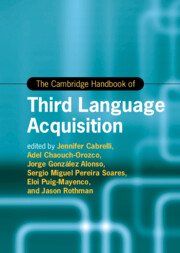Book contents
- The Cambridge Handbook of Third Language Acquisition
- Cambridge Handbooks in Language and Linguistics
- The Cambridge Handbook of Third Language Acquisition
- Copyright page
- Contents
- Figures
- Tables
- Contributors
- Introduction Multilingualism
- Part I Theoretical Approaches to L3/Ln
- Part II L3/Ln across Linguistic Domains
- 5 Exploring the Acquisition of L3 Phonology
- 6 Characteristics of the L3 Lexicon
- 7 Processing Words in a Multilingual Lexicon
- 8 Full Transfer in L3/Ln Acquisition
- 9 Full Transfer Potential in L3/Ln Acquisition
- 10 The Acquisition and Processing of Pragmatics in Multilinguals and Third Language Learners
- Part III Becoming and Staying Multilingual at Different Ages
- Part IV L3/Ln in Action
- Part V L3/Ln and Cognition
- Part VI Research Methods in L3/Ln
- Index
- References
6 - Characteristics of the L3 Lexicon
from Part II - L3/Ln across Linguistic Domains
Published online by Cambridge University Press: 13 July 2023
- The Cambridge Handbook of Third Language Acquisition
- Cambridge Handbooks in Language and Linguistics
- The Cambridge Handbook of Third Language Acquisition
- Copyright page
- Contents
- Figures
- Tables
- Contributors
- Introduction Multilingualism
- Part I Theoretical Approaches to L3/Ln
- Part II L3/Ln across Linguistic Domains
- 5 Exploring the Acquisition of L3 Phonology
- 6 Characteristics of the L3 Lexicon
- 7 Processing Words in a Multilingual Lexicon
- 8 Full Transfer in L3/Ln Acquisition
- 9 Full Transfer Potential in L3/Ln Acquisition
- 10 The Acquisition and Processing of Pragmatics in Multilinguals and Third Language Learners
- Part III Becoming and Staying Multilingual at Different Ages
- Part IV L3/Ln in Action
- Part V L3/Ln and Cognition
- Part VI Research Methods in L3/Ln
- Index
- References
Summary
One of the main characteristics of the L3 lexicon is that it manifests influences from all previously learned languages, in contrast to the L2 lexicon, which can only be influenced by the L1. The chapter thus focuses on L1 and L2 lexical crosslinguistic influences in the L3. Questions discussed include the extent to which the L1(s) and L2(s) influence the L3 lexicon; in what ways they do so; and why certain background languages tend to influence the L3 lexicon to a larger extent than others. The chapter looks at both so-called negative transfer, such as code-switches, word construction attempts, and semantic transfer, and positive transfer effects, such as to what extent the L3 lexicon benefits from L1 and L2 cognate knowledge. The research area is complex in many different ways. It will be shown that it encompasses various types of data, different language constellations, L3 settings, L3 (and L2) proficiency levels, and age groups.
- Type
- Chapter
- Information
- The Cambridge Handbook of Third Language Acquisition , pp. 142 - 164Publisher: Cambridge University PressPrint publication year: 2023
References
- 1
- Cited by

